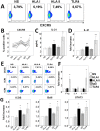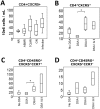Allogeneic dendritic cells stimulated with antibodies against HLA class II polarize naive T cells in a follicular helper phenotype
- PMID: 29507364
- PMCID: PMC5838222
- DOI: 10.1038/s41598-018-22391-w
Allogeneic dendritic cells stimulated with antibodies against HLA class II polarize naive T cells in a follicular helper phenotype
Abstract
Follicular helper T cells (Tfh) are crucial for the production of high-affinity antibodies, such as alloantibodies, by providing the signals for B-cell proliferation and differentiation. Here, we demonstrate that human allogeneic dendritic cells (DC) stimulated with antibodies against HLA class II antigens preferentially differentiate human naive CD4+ T cells into Tfh cells. Following coculture with DCs treated with these antibodies, CD4+ T cells expressed CXCR5, ICOS, IL-21, Bcl-6 and phosphorylated STAT3. Blockade of IL-21 abrogated Bcl-6, while addition of the IL-12p40 subunit to the coculture increased CXCR5, Bcl-6, phosphorylated STAT3 and ICOS, indicating that they were both involved in Tfh polarization. We further phenotyped the peripheral T cells in a cohort of 55 kidney transplant recipients. Patients with anti-HLA-II donor-specific antibodies (DSA) presented higher blood counts of circulating Tfh cells than those with anti-HLA-I DSAs. Moreover, there was a predominance of lymphoid aggregates containing Tfh cells in biopsies from patients with antibody-mediated rejection and anti-HLA-II DSAs. Collectively, these data suggest that alloantibodies against HLA class II specifically promote the differentiation of naive T cells to Tfh cells following contact with DCs, a process that might appear in situ in human allografts and constitutes a therapeutic target.
Conflict of interest statement
The authors declare no competing interests.
Figures





Similar articles
-
CXCR5+PD1+ICOS+ Circulating T Follicular Helpers Are Associated With de novo Donor-Specific Antibodies After Renal Transplantation.Front Immunol. 2019 Sep 10;10:2071. doi: 10.3389/fimmu.2019.02071. eCollection 2019. Front Immunol. 2019. PMID: 31552030 Free PMC article.
-
CD4+ T Cell Help Is Mandatory for Naive and Memory Donor-Specific Antibody Responses: Impact of Therapeutic Immunosuppression.Front Immunol. 2018 Feb 19;9:275. doi: 10.3389/fimmu.2018.00275. eCollection 2018. Front Immunol. 2018. PMID: 29515582 Free PMC article.
-
Distinct phenotypic subpopulations of circulating CD4+CXCR5+ follicular helper T cells in children with active IgA vasculitis.BMC Immunol. 2016 Oct 21;17(1):40. doi: 10.1186/s12865-016-0176-6. BMC Immunol. 2016. PMID: 27769184 Free PMC article.
-
T Follicular Helper Cells in Transplantation.Transplantation. 2016 Aug;100(8):1650-5. doi: 10.1097/TP.0000000000001217. Transplantation. 2016. PMID: 27362303 Review.
-
Role of TRAFs in Signaling Pathways Controlling T Follicular Helper Cell Differentiation and T Cell-Dependent Antibody Responses.Front Immunol. 2018 Oct 22;9:2412. doi: 10.3389/fimmu.2018.02412. eCollection 2018. Front Immunol. 2018. PMID: 30405612 Free PMC article. Review.
Cited by
-
CXCR5+PD1+ICOS+ Circulating T Follicular Helpers Are Associated With de novo Donor-Specific Antibodies After Renal Transplantation.Front Immunol. 2019 Sep 10;10:2071. doi: 10.3389/fimmu.2019.02071. eCollection 2019. Front Immunol. 2019. PMID: 31552030 Free PMC article.
-
T follicular helper cells expansion in transplant recipients correlates with graft infiltration and adverse outcomes.Front Immunol. 2024 Feb 7;15:1275933. doi: 10.3389/fimmu.2024.1275933. eCollection 2024. Front Immunol. 2024. PMID: 38384450 Free PMC article.
-
Adaptive immune cell responses as therapeutic targets in antibody-mediated organ rejection.Trends Mol Med. 2022 Mar;28(3):237-250. doi: 10.1016/j.molmed.2022.01.002. Epub 2022 Jan 29. Trends Mol Med. 2022. PMID: 35093288 Free PMC article. Review.
-
The suppressive effect on CD4 T cell alloresponse against endothelial HLA-DR via PD-L1 induced by anti-A/B ligation.Clin Exp Immunol. 2020 Nov;202(2):249-261. doi: 10.1111/cei.13482. Epub 2020 Jul 18. Clin Exp Immunol. 2020. PMID: 32578199 Free PMC article.
References
-
- Sellares J, et al. Understanding the causes of kidney transplant failure: the dominant role of antibody-mediated rejection and nonadherence. American journal of transplantation: official journal of the American Society of Transplantation and the American Society of Transplant Surgeons. 2012;12:388–399. doi: 10.1111/j.1600-6143.2011.03840.x. - DOI - PubMed
-
- Sellares J, et al. Molecular diagnosis of antibody-mediated rejection in human kidney transplants. American journal of transplantation: official journal of the American Society of Transplantation and the American Society of Transplant Surgeons. 2013;13:971–983. doi: 10.1111/ajt.12150. - DOI - PubMed
Publication types
MeSH terms
Substances
Grants and funding
LinkOut - more resources
Full Text Sources
Other Literature Sources
Research Materials
Miscellaneous

